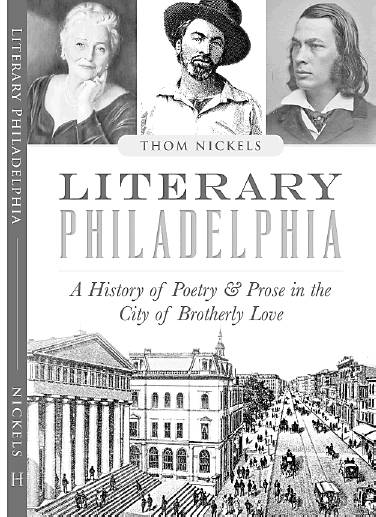BOOKS
Philadelphia in prose, poetry
Literary history of the city covers past treasures and trademarks — plus little-known authors
Reviewed by Kathye Fetsko Petrie
Literary Philadelphia
A History of Poetry & Prose in the City of Brotherly Love By Thom Nickels
Arcadia. 160 pp. $21.99
Agnes Repplier (1855-1950) was known as the “American Jane Austen,” her work praised by no less than Henry James, Walt Whitman, and Edith Wharton. Who knew?
“She was world-famous,” journalist/author Thom Nickels said recently at a reading of his new book, Literary Philadelphia, at Barnes & Noble on Rittenhouse Square. Repplier lived here for all 92 years of her life. Nickels wonders why “the city doesn’t have a bridge named after her or at least a plaque outside her house at 901 Clinton St.”
There is a Pennsylvania Historical Marker outside 5427 Germantown Ave., the approximate location of the now-gone “Pine Place” where Little Women author Louisa May Alcott (1832-88) lived the first two years of her life. This plaque aside, it may come as a surprise to many that Alcott — so often thought of as a New Englander — was indeed born in Philadelphia.
Literary Philadelphia is peppered with many such unexpected literary treasures. What a surprise to learn the novel The Virginian was written by a Philadelphian. Equally surprising is the description of 18th-century Philadelphia’s Sin City period — you know, that time when casual sex in alleyways was everywhere, when treatment for sexual disease could be purchased in a bookstore.
You may think you know all there is to know about our trademark historic writers — Thomas Paine, Benjamin Franklin, Edgar Allan Poe, James Michener, Pearl S. Buck. And, yet, Nickels relates some surprising anecdotes about them. Not all are pleasant. Benjamin Franklin made some very Donald Trump-like remarks about immigrants, as well as racist comments — words too awful for me to repeat here.
Literary Philadelphia contains amusing descriptions of places such as Apley’s bookstore, the 19th-century Chestnut Street bookshop with display windows “so thick with dirt and rubbish that it was difficult to see the titles of the books.” I loved reading about the little stretch of Camac Street between Walnut and Locust that has been known variously as “The Little Street of Clubs” and “Egghead Row” because the place was (and still is) full of literary and art salons.
The history of Washington Square itself is haunting. Nickels reminds us that bodies of Revolutionary War soldiers, as well as victims of the 1793 yellow fever epidemic, are interred beneath the sidewalks and green expanses of the park where we now walk. He also tells us how author Charles Godfrey Leland (1824-1903), who lived in a house opposite Washington Square, wrote in his Memoirs about an unsettling feeling in the park, and of “confused forms seen flitting over it in the night.”
In the Barnes & Noble cafe the night of Nickels’ talk, prominent poet Lamont B. Steptoe — who is featured in Nickels’ book — told me that, while working on poems in Washington Park, he definitely “felt the spirits” there.
Nickels’ book brushes only lightly on today’s local literary scene. The last chapter contains paragraphs on novelists including Pete Dexter and Cordelia Biddle; poets including Sonia Sánchez (Philadelphia’s first poet laureate), the late Daniel Hoffman, Eleanor Wilner, Daniel Abdal-Hayy Moore, Daisy Fried, and Steptoe; and journalists including Carol Saline and Buzz Bissinger. Authors Ken Kalfus, Lisa Scottoline, Jennifer Weiner, Jon McGoran, and Simone Zelitch are mentioned only in the final sentence.
But this city is rich with other writers worthy of inclusion in a history of our current literary scene. I was wishing I could have seen more of their names here. To be fair, comprehensiveness is never promised in Literary Philadelphia and was probably never possible. Nickels acknowledges as much in his final paragraph: “While a book like Literary Philadelphia cannot include every working (talented) writer in the city, it can certainly set the stage for a wider canvas in the future.”
I agree. Literary Philadelphia is a wonderful introduction to/overview of our abundant literary heritage. At the same time, because of that abundance, I call for a sequel.
Kathye Fetsko Petrie is a freelance writer and the editor/founder of Local LIT
